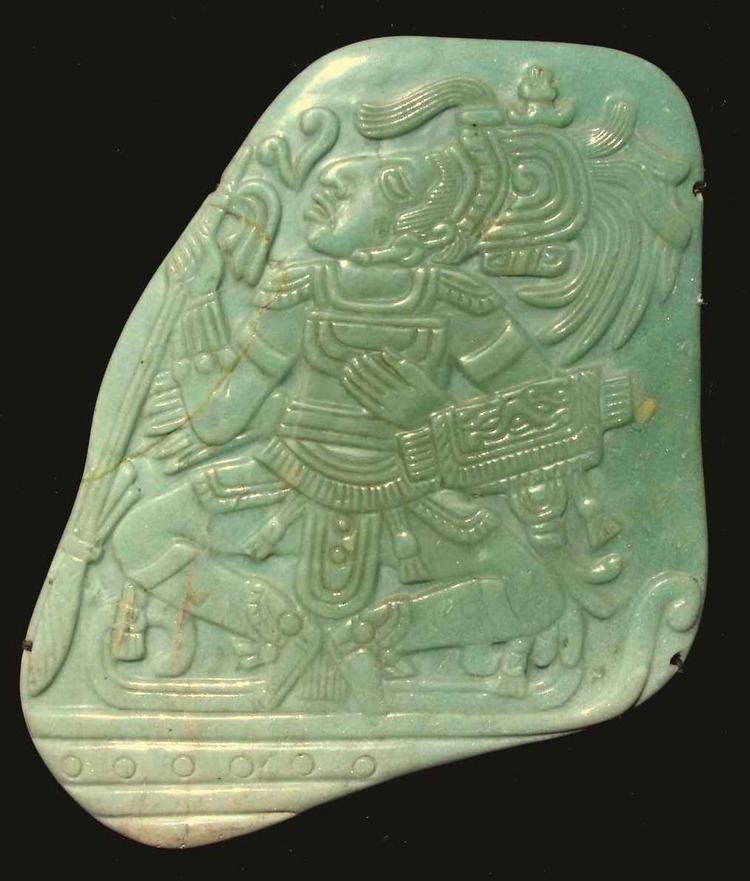 | ||
Some view Jade use in Mesoamerica as largely influenced by the conceptualization of the material as a rare and valued commodity among pre-Columbian Mesoamerican cultures, such as the Olmec, the Maya, and the various groups in the Valley of Mexico. Until the 21st century, it was thought the only source from which the indigenous cultures could obtain jade was the Motagua River valley in Guatemala. In addition to being an elite good of highly symbolic use in the performance of ideological ritual the high pressure minerals that form the translucent rocks termed jades are much tougher and more damage resistant than slightly harder but far more brittle materials such as flint.
Contents
This extreme durability makes fine grained or fibrous jadeite and nephrite in effect the 'steel' of neolithic technology. It was often worked or carved in a variety of ways, either as ornamental stones, a medium upon which hieroglyphs were inscribed, or shaped into figurines, weapons, and other objects. Many jade artifacts crafted by later Mesoamerican civilizations, appear cut from simple jade axes, implying that the earliest trade had a utilitarian component.
The general term jade refers to two separate rock types. The first is called nephrite, a calcium and magnesium rich amphibole mineral. Nephrite does not exist in Mesoamerica.
The second is jadeite, a pyroxene rich in sodium and aluminum. Variation in color is largely due to variation in trace element composition. In other words, the types of trace elements and their quantities affect the overall color of the material. The “Olmec Blue” jade owes its unique color to the presence of iron and titanium, while the more typical green jade’s color is due to the varying presence of sodium, aluminum, iron, and chromium. Translucence can vary as well, with specimens ranging form nearly clear to completely opaque.
Among Mesoamerican archaeologists, "jade" is sometimes used in a manner that does not differentiate between jadeite and other similar-looking, relatively hard greenstones such as albitite, omphacite, chrysoprase, and quartzite.
Art
Jade was shaped into a variety of objects including, but not limited to, figurines, celts, ear spools (circular earrings with a large hole in the center), and teeth inlays (small decorative pieces inserted into the incisors). Mosaic pieces of various sizes were used to decorate belts and pectoral coverings.
Jade sculpture often depicted deities, people, shamanic transformations, animals and plants, and various abstract forms. Sculptures varied in size from single beads, used for jewelry and other decorations, to large carvings, such as the 4.42 kilogram head of the Maya sun god found at Altun Ha. Jade workshop areas have been documented at two Classic Maya sites in Guatemala: Cancuen and Guaytan. The archaeological investigation of these workshops has informed researchers on how jadeite was worked in ancient Mesoamerica.
Religion
The value of jade went beyond its material worth. Perhaps because of its color, mirroring that of water and vegetation, it was symbolically associated with life and death and therefore possessed high religious and spiritual importance.
The Maya placed jade beads in the mouth of the dead. Michael D. Coe has suggested that this practice relates to a sixteenth-century funerary ritual performed at the deaths of Pokom Maya lords: "When it appears then that some lord is dying, they had ready a precious stone which they placed at his mouth when he appeared to expire, in which they believe that they took the spirit, and on expiring, they very lightly rubbed his face with it. It takes the breath, soul or spirit."
The Maya also associated jade with the sun and the wind. Many Maya jade sculptures and figurines of the wind god have been discovered, as well as many others displaying breath and wind symbols. In addition, caches of four jade objects placed around a central element which have been found are believed to represent not only the cardinal directions, but the directional winds as well.
The aesthetic and religious significance of the various colors remains a source of controversy and speculation. The bright green varieties may have been identified with the young Maize God. The Olmec were fascinated with the unique blue jade of Guatemala and it played an important role in their rituals involving water sources. The Olmec used blue jade because it represented water, an Olmec iconography representing the Underworld. Blue also represented the blue color that snakes turn before shedding their skin; therefore, blue represents aquatic and serpentine rejuvenation.
Working jade
Next to emery, jade was the hardest mineral known to ancient Mesoamerica. In the absence of metal tools, ancient craftsmen used tools themselves made of jade, leather strops, string saws to cut and carve jade, and reeds or other hard materials to drill holes. (Mesoamerican artisans also used jade tools to work other stones.) It would take many hours of work to create even a single jade bead.
